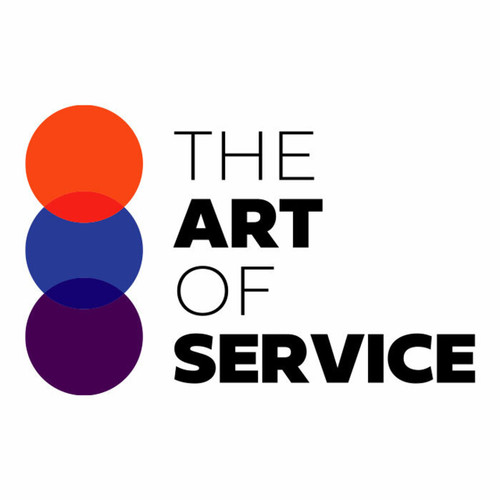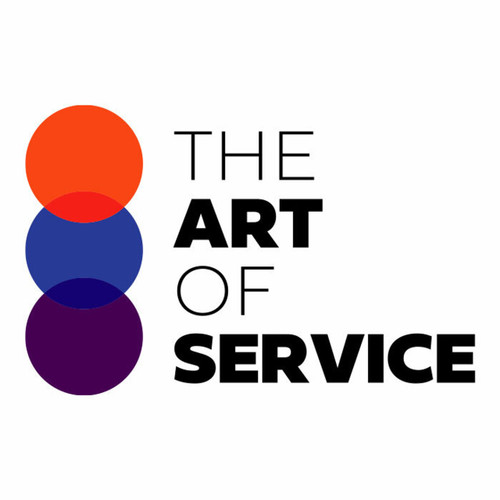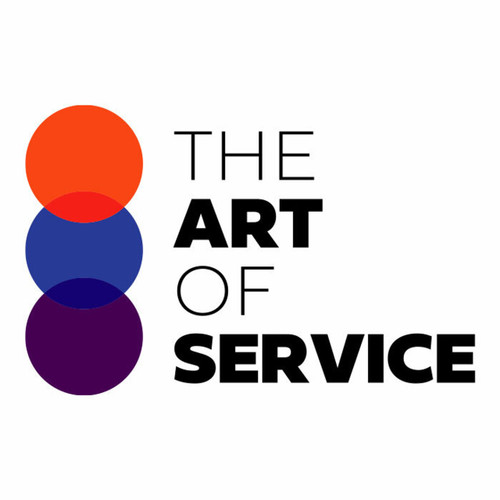Our dataset consists of 1544 prioritized FMEA and Functional Safety requirements, solutions, benefits, results, and real-world case studies/use cases.
This knowledge base is specifically designed to help professionals like you successfully navigate the complexities of FMEA and Functional Safety, saving you time and resources.
Compared to other alternatives on the market, our Failure Mode And Effects Analysis and Functional Safety dataset stands out for its thoroughness and usability.
It covers all aspects of FMEA and Functional Safety, making it a go-to resource for professionals in various industries.
Not only is our dataset user-friendly, but it is also affordable and suitable for DIY implementation.
We understand that as a busy professional, you need a product that is easy to use and budget-friendly.
With our product, you can easily access important questions, prioritize tasks by urgency and scope, and get immediate results.
This will allow you to identify potential failures and safety hazards early on, mitigating any risks and potential downtime.
But don′t just take our word for it - our dataset has been thoroughly researched and tested to ensure its effectiveness.
Countless businesses have already seen the benefits of implementing our Failure Mode And Effects Analysis and Functional Safety Knowledge Base.
Don′t waste any more time and resources on unreliable FMEA and Functional Safety methods.
Upgrade to our dataset and experience the peace of mind and efficiency it brings.
Order now and discover why our product is the top choice for professionals like yourself.
Discover Insights, Make Informed Decisions, and Stay Ahead of the Curve:
Key Features:
Comprehensive set of 1544 prioritized Failure Mode And Effects Analysis requirements. - Extensive coverage of 123 Failure Mode And Effects Analysis topic scopes.
- In-depth analysis of 123 Failure Mode And Effects Analysis step-by-step solutions, benefits, BHAGs.
- Detailed examination of 123 Failure Mode And Effects Analysis case studies and use cases.
- Digital download upon purchase.
- Enjoy lifetime document updates included with your purchase.
- Benefit from a fully editable and customizable Excel format.
- Trusted and utilized by over 10,000 organizations.
- Covering: Safety Case Development, Agile Methodologies, Automotive Industry, Safety Planning, Hardware Fault Tolerance, ISO 26262, Safety Culture, Safety Guidelines Compliance, Functional Level, Functional Safety Requirements, Safety Implementation, Safety Budgeting, Safety Compliance, Safety Performance, Safety Verification Plan, Safety Documentation Review, Safety Standards, Safety Procedures, Software Fault Tolerance, Safety Control System Verification, Safety Assurance, Functional Safety Analysis, Reliability Analysis, Safety Requirements Allocation, Safety Requirements Traceability, Safety Training Programs, Safety Standards Implementation, Safety Critical, Risk Analysis, Safety Certification, Risk Mitigation, but I, Safety Auditing, Safety Control Systems, Safety Systems, Safety Verification, Safety Protocols, Safety Controls Implementation, Safety Performance Metrics, Ensuring Safety, Safety Framework, Safety Software, Safety Training Plan, Safety Integration, Software Safety Requirements, Systems Review, Functional Safety, Safety Training, Safety Strategies, Safety Documentation, Safety Analysis Methods, Reliability Allocation, Safety Architecture, Safety Lifecycle, Safety Measures, Risk Assessment, Automated Driving, Safety Management, Automotive Safety, Networked Control, Control System Engineering, Fail Safe Design, Functional Safety Standards, Safety Engineering, Safety Guidelines Development, Safety Assessments, Fun In The Workplace, Safety Verification Testing, Functional Limitations, Safety Planning Process, Safety Requirements, Environmental Safety, Safety System Performance Analysis, Defensive Design, Reliability Engineering, Safety Validation, Corporate Security, Safety Monitoring Techniques, Societal Impact, Safety Testing, Safety Validation Plan, Safety Software Development, Safety Management Plan, Safety Standards Development, Safety Monitoring, Testing Environments, Safety Integrity Level, Separation Equipment, Safety Integrity, Safety mechanisms, Safety Assessment Criteria, Quality Assurance, Safety Audits, Safety Review, Safety Management Strategies, Dev Test, Hardware Interfacing, Incident Frequency, Customer Education, Functional Safety Management, ISO 13849, Failure Modes, Safety Communication Strategies, Safety Functions, Vehicle Maintenance And Inspection, Safety Procedure Assessment, Product Safety, Failure Mode And Effects Analysis, Safety Risk Evaluation, Safety Inspections And Audits, Safety Checks, Safety Assessment, Emergency Stop System, Risk Reduction, Safety Management System, Critical Incident Response Team, Design For Safety, Hazard Identification, Safety Control Measures, Safety Guidelines, Safety Inspections, Safety Regulations, Safety Controls
Failure Mode And Effects Analysis Assessment Dataset - Utilization, Solutions, Advantages, BHAG (Big Hairy Audacious Goal):
Failure Mode And Effects Analysis
Failure Mode and Effects Analysis (FMEA) is a method used to identify potential failures within a system or process and assess their potential effects in order to implement preventive measures and improve safety.
- Systematic evaluation of potential failure modes and their effects enables identification and implementation of effective safety measures.
- Identifying potential failure modes early in the development process helps reduce costs and time associated with safety modifications.
- Prioritizing failure modes based on their severity allows for concentrated efforts on the most critical aspects of safety.
- Provides a systematic approach for documenting and communicating safety considerations to all stakeholders.
- Allows for continuous improvement and modification of safety measures as the system evolves.
CONTROL QUESTION: Has the system been designed and built to meet applicable safety standards?
Big Hairy Audacious Goal (BHAG) for 10 years from now:
In 10 years, our Failure Mode and Effects Analysis system will have revolutionized the safety standards in the industry. With cutting-edge technology and rigorous testing processes, it will be the go-to tool for all organizations to ensure the reliability and functionality of their systems. Our FMEA system will have been adopted globally, making safety a top priority for all industries. We aim to achieve a zero-failure rate across all systems, saving lives and preventing catastrophic failures. Our ultimate goal is to create a world where failure mode analysis is no longer necessary because all systems are built with the utmost safety and efficiency in mind.
Customer Testimonials:
"The creators of this dataset did an excellent job curating and cleaning the data. It`s evident they put a lot of effort into ensuring its reliability. Thumbs up!"
"The personalized recommendations have helped me attract more qualified leads and improve my engagement rates. My content is now resonating with my audience like never before."
"The variety of prioritization methods offered is fantastic. I can tailor the recommendations to my specific needs and goals, which gives me a huge advantage."
Failure Mode And Effects Analysis Case Study/Use Case example - How to use:
Synopsis:
The client, a leading healthcare organization, was in the final stages of developing and implementing a new medical device for use in hospitals and clinics. The device was designed to automate certain medical procedures, thereby reducing the risk of human error and improving patient outcomes. However, in light of recent safety concerns regarding medical devices, the client wanted to ensure that their product was in compliance with all applicable safety standards and regulations. As such, they engaged a team of consultants to perform a Failure Mode and Effects Analysis (FMEA) to determine if their system had been designed and built to meet these standards.
Consulting Methodology:
The consulting team followed a comprehensive and structured approach to conduct the FMEA. This began with a thorough review of the medical device’s design and specifications, as well as relevant safety standards, regulations, and industry best practices. The team then conducted interviews with key stakeholders, including engineers, designers, and product managers, to gain a deeper understanding of the system’s functionalities and potential failure modes. This was followed by a detailed analysis of the potential effects of each failure mode on system performance, safety, and reliability. The final step involved developing a risk mitigation plan and recommendations for addressing any identified weaknesses or gaps in the system.
Deliverables:
The key deliverables of the FMEA included a comprehensive report and a risk mitigation plan. The report provided an overview of the system, the FMEA methodology used, and a detailed analysis of potential failure modes and their effects on the system. It also included recommendations for improving the system’s safety and compliance with applicable standards. The risk mitigation plan outlined specific actions that needed to be taken to address the identified failure modes, including any necessary design changes, safety testing, and further documentation.
Implementation Challenges:
One of the main challenges faced during the FMEA was obtaining accurate and up-to-date information about the system’s design and functionalities. This required close collaboration with the client’s engineering team, who provided valuable insights and inputs. Additionally, the team had to ensure that they were up-to-date with the latest safety standards and regulations, which are constantly evolving in the healthcare industry. Another challenge was identifying and assessing potential failure modes that were not initially considered by the product team.
KPIs:
The success of the FMEA was measured through several key performance indicators (KPIs), including the number of potential failure modes identified, the effectiveness of the risk mitigation plan in addressing these modes, and the overall compliance of the system with applicable safety standards. The project was also evaluated based on its impact on reducing the likelihood of system failures and improving patient safety.
Management Considerations:
In addition to the specific recommendations outlined in the risk mitigation plan, the consulting team provided broader management considerations for the client to ensure the ongoing safety and compliance of the medical device. This included establishing a regular review process to identify any new failure modes that may arise as the system evolves or as new safety standards are introduced. The team also recommended implementing a robust training program to educate staff on the correct operation and use of the device, as well as potential hazards and safety protocols.
Conclusion:
The FMEA conducted by the consulting team provided the client with valuable insights into potential failure modes and their effects on the system’s safety and compliance with standards. By closely working with the product team and following a comprehensive methodology, the team was able to identify and mitigate risks, ensuring that the system was designed and built to meet all applicable safety standards. The project not only helped the client address any potential safety concerns but also demonstrated their commitment to addressing emerging issues and continuously improving their products.
Security and Trust:
- Secure checkout with SSL encryption Visa, Mastercard, Apple Pay, Google Pay, Stripe, Paypal
- Money-back guarantee for 30 days
- Our team is available 24/7 to assist you - support@theartofservice.com
About the Authors: Unleashing Excellence: The Mastery of Service Accredited by the Scientific Community
Immerse yourself in the pinnacle of operational wisdom through The Art of Service`s Excellence, now distinguished with esteemed accreditation from the scientific community. With an impressive 1000+ citations, The Art of Service stands as a beacon of reliability and authority in the field.Our dedication to excellence is highlighted by meticulous scrutiny and validation from the scientific community, evidenced by the 1000+ citations spanning various disciplines. Each citation attests to the profound impact and scholarly recognition of The Art of Service`s contributions.
Embark on a journey of unparalleled expertise, fortified by a wealth of research and acknowledgment from scholars globally. Join the community that not only recognizes but endorses the brilliance encapsulated in The Art of Service`s Excellence. Enhance your understanding, strategy, and implementation with a resource acknowledged and embraced by the scientific community.
Embrace excellence. Embrace The Art of Service.
Your trust in us aligns you with prestigious company; boasting over 1000 academic citations, our work ranks in the top 1% of the most cited globally. Explore our scholarly contributions at: https://scholar.google.com/scholar?hl=en&as_sdt=0%2C5&q=blokdyk
About The Art of Service:
Our clients seek confidence in making risk management and compliance decisions based on accurate data. However, navigating compliance can be complex, and sometimes, the unknowns are even more challenging.
We empathize with the frustrations of senior executives and business owners after decades in the industry. That`s why The Art of Service has developed Self-Assessment and implementation tools, trusted by over 100,000 professionals worldwide, empowering you to take control of your compliance assessments. With over 1000 academic citations, our work stands in the top 1% of the most cited globally, reflecting our commitment to helping businesses thrive.
Founders:
Gerard Blokdyk
LinkedIn: https://www.linkedin.com/in/gerardblokdijk/
Ivanka Menken
LinkedIn: https://www.linkedin.com/in/ivankamenken/







